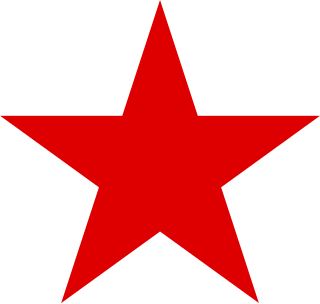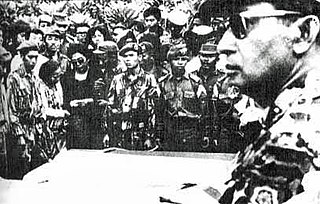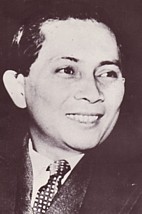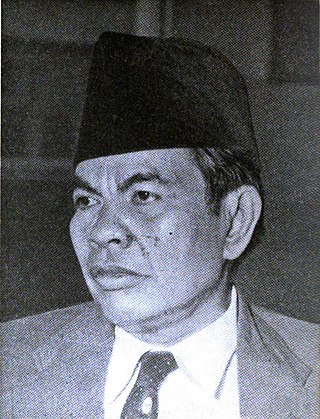Related Research Articles

The Communist Party of Indonesia was a communist party in Indonesia. It was the largest non-ruling communist party in the world before its violent disbandment in 1965. The party had two million members in the 1955 elections, with 16 percent of the national vote and almost 30 percent of the vote in East Java. During most of the period immediately following the Indonesian Independence until the eradication of the PKI in 1965, it was a legal party operating openly in the country.

The Socialist Party of Indonesia was a political party in Indonesia from 1948 until 1960, when it was banned by President Sukarno.

Indonesia's transition to the New Order in the mid-1960s ousted the country's first president, Sukarno, after 22 years in the position. One of the most tumultuous periods in the country's modern history, it was the commencement of Suharto's 31-year presidency.

The position of Prime Minister of Indonesia existed from 1945 until 1966. During this period, the prime minister was in charge of the Cabinet of Indonesia, one of the three branches of government along with the People's Representative Council and the president. Following his 1959 decree, President Sukarno assumed the role and powers of prime minister until his resignation in 1966.

Mohammad Yamin was an Indonesian poet, politician and national hero who played a key role in the writing of the draft preamble to the 1945 constitution.

The Indonesian Students' Action Front, better known as KAMI, was a student organization founded and led by anti-communist university students in Indonesia. The group was formed to spearhead the suppression of the Indonesian Communist Party, and the left-wing in general, following an abortive coup d'état attempt in 1965.

The Central Indonesian National Committee, or KNIP, was a body appointed to assist the president of the newly independent Indonesia. Originally purely advisory, it later gained assumed legislative functions. The Working Committee of the KNIP became part of the People's Representative Council when Indonesia became a unitary state in 1950.

Sitor Situmorang was an Indonesian poet, essayist and writer of short stories. Situmorang was born in Harianboho, North Sumatra, and educated in Jakarta. He worked as a journalist and literary critic in Medan, Yogyakarta and Jakarta for a variety of newspapers and periodicals.

Achdiat Karta Mihardja was an Indonesian author, novelist and playwright. He is best known for his novel, Atheis, which was published in 1949. Atheis is considered one of Indonesia's most important literary works following World War II.

Hans Bague Jassin, better known as HB Jassin, was an Indonesian literary critic, documentarian, and professor. Born in Gorontalo to a bibliophilic petroleum company employee, Jassin began reading while still in elementary school, later writing published reviews before finishing high school. After a while working in the Gorontalo regent's office, he moved to Jakarta where he worked at the state publisher Balai Pustaka. After leaving the publisher, he attended the University of Indonesia and later Yale. Returning to Indonesia to be a teacher, he also headed Sastra magazine. Horison, a literary magazine, was started in July 1966 by Jassin and Mochtar Lubis as a successor to Sastra, and was edited by Taufiq Ismail, Ds. Muljanto, Zaini, Su Hok Djin, and Goenawan Mohamad. In 1971, Jassin was given a one-year prison sentence and a two-year probation period because as the editor of Sastra, he refused to reveal the identity of an anonymous writer who wrote a story which was considered by the court to be blasphemous.
"Langit Makin Mendung" is a controversial Indonesian short story. Published in Sastra magazine under the pen name Kipandjikusmin in August 1968, it tells the story of Muhammad descending to Earth with the angel Gabriel to investigate the decreasing number of Muslims entering heaven, only to find that Muslims in Indonesia have begun fornicating, drinking alcohol, waging war on Muslims, and otherwise going against the tenets of Islam because of nasakom, a government policy during Sukarno's administration that combined nationalism, religion, and communism. Unable to do anything to stop the rampant sinning, Muhammad and Gabriel—having taken the form of eagles—watch the political maneuvering, crime, and famine in Jakarta.

Agam Wispi is an Indonesian poet.

Tengku Amir Hamzah was an Indonesian poet and National Hero of Indonesia. Born into a Malay aristocratic family in the Sultanate of Langkat in North Sumatra, he was educated in both Sumatra and Java. While attending senior high school in Surakarta around 1930, Amir became involved with the nationalist movement and fell in love with a Javanese schoolmate, Ilik Sundari. Even after Amir continued his studies in legal school in Batavia the two remained close, only separating in 1937 when Amir was recalled to Sumatra to marry the sultan's daughter and take on responsibilities of the court. Though unhappy with his marriage, he fulfilled his courtly duties. After Indonesia proclaimed its independence in 1945, he served as the government's representative in Langkat. The following year he was killed in a social revolution led by the PESINDO, and buried in a mass grave.

Poedjangga Baroe was an Indonesian avant-garde literary magazine published from July 1933 to February 1942. It was founded by Armijn Pane, Amir Hamzah, and Sutan Takdir Alisjahbana.

Bakri Siregar was an Indonesian socialist literary critic and writer.
The Cultural Manifesto was a declaration by a group of Indonesian writers and intellectuals in late 1963. The Cultural Manifesto was initiated by HB Jassin, Trisno Sumardjo, Wiratmo Soekito, Zaini, Bokor Hutasuhut, Gunawan Mohamad, A. Bastari Asnin, Bur Rasuanto, Soe Hok Djin, DS Moeljanto, Ras Siregar, Hartojo Andangdjaja, Sjahwil, Djufri Tanissan, Binsar Sitompul, Gerson Poyk, Taufiq Ismail, M. Saribi, Poernawan Tjondronegoro, Ekana Siswojo, Nashar and Boen S. Oemarjati. The group that constituted the Cultural Manifesto was in ideological contrast to Lekra. Members of the Lekra movement nicknamed the Cultural Manifesto "Manikebu," a humorous abbreviation that in English means "Buffalo Sperm."

Basoeki Resobowo was an Indonesian painter. Born to a transmigrant father in Sumatra, from a young age he showed interest in the visual arts but was taught to be a teacher. After a short time at a Taman Siswa school in Batavia, he studied design and worked as a surveyor while producing sketches and book covers. He only acted in a single film, Kedok Ketawa, but remained close to the acting community, first as a set designer during the Japanese occupation of the Dutch East Indies then for Perfini in the early 1950s.

Bachtiar Siagian was an Indonesian film director and scriptwriter, who was "arguably the country's most significant leftist film director and theorist". He was a leading figure of Lembaga Kebudajaan Rakjat (LEKRA),. His film Turang (1957) won the main price at the Indonesian Film Festival in Jakarta in 1960. In 2016 he posthumously received the 'Creator, Pioneer and Innovator Cultural Award' from the Indonesian Ministry of Education and Culture.
References
- Footnotes
- 1 2 3 4 5 6 7 8 9 Cribb & Kahin 2004, pp. 241–242.
- ↑ Bodden 2010, p. 53.
- ↑ Rampan 2000, p. 189.
- 1 2 Bodden 2010, p. 47.
- Bibliography
- Bodden, Michael (2010). "Modern Drama, Politics, and the Postcolonial Aesthetics of Left-Nationalism in Sumatra: The Forgotten Theater of Indonesia's Lekra, 1955-1965". In Day, Tony (ed.). Cultures at War: The Cold War and Cultural Expression in Southeast Asia. Studies on Southeast Asia. Ithaca, New York: Southeast Asia Program Publications. ISBN 978-0-8108-4935-8.
- Cribb, Robert; Kahin, Audrey (2004). Historical Dictionary of Indonesia. Historical dictionaries of Asia, Oceania, and the Middle East. Lanham, Maryland: Scarecrow Press. ISBN 978-0-8108-4935-8.
- Rampan, Korrie Layun (2000). Leksikon Susastra Indonesia [A Lexicon of Indonesian Literature] (in Indonesian). Jakarta: Balai Pustaka. ISBN 978-979-666-358-3.